1993 BUICK REGAL warning
[x] Cancel search: warningPage 11 of 308
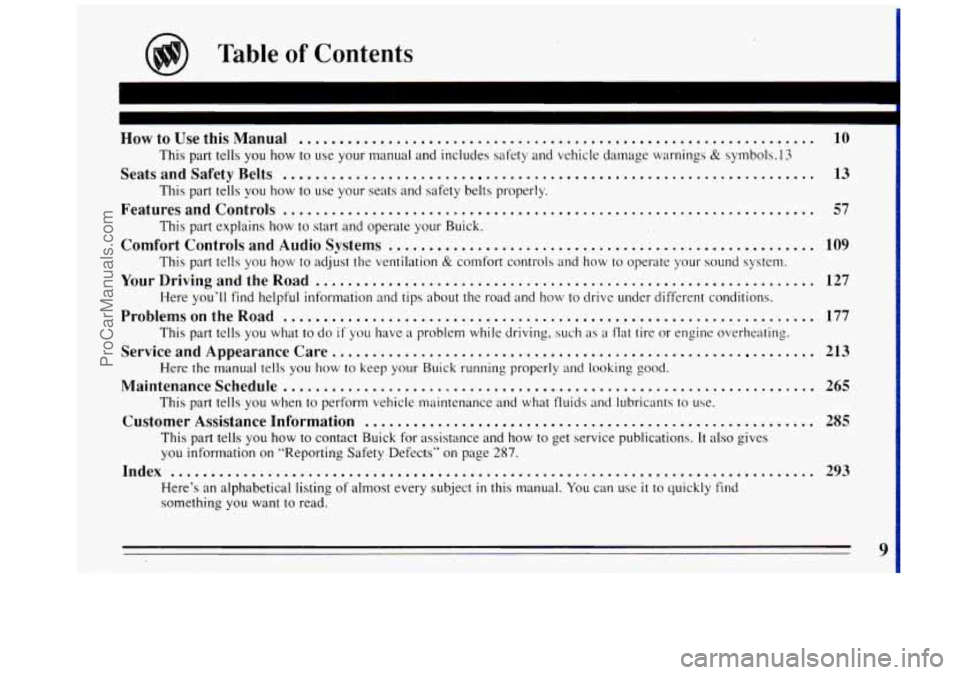
HowtoUsethisManual ................................................................ 10
Seats and Safety Belts
. . . . . . . . . . . . . . . . . . . . . . . . . . . . . . . . . . . . . . . . . . . . . . . . . . *. . . . . *. . . . . . . . 13
FeaturesandControls
.................................... ............................... 57
Comfort Controls and Audio Systems . . . . . . . . . . . . . . . . . . . . . . . . . . . . . . . . . . . . . . . . . . . . . . . . I.. . I 109
YourDrivingandtheRoad
.............0.0..........s...................................... 127
ProblemsontheRoad
.................................................................. 177
Service and Appearance Care..
. . . . . . . . . . . . e . . . . . . . . . . . . . . . . . . . . . . . . . . . . . . . . . . . . . . . . . . 213
Maintenanceschedule
.................................................................. 265
Customer Assistance Information
. . . . . . . . . . . . . . . . . . . . . . . . . . . . . . . . . . . . . . . . . . . . . . . . . . . . . . . . 285
This part tells you how to use your manual and includes safety and vehicle damage warnings & symbols. 13
This part tells you how to use your seats and safety belts properly.
This part explains how
to start and operate your Buick.
This part tells you how to adjust the ventilation
& comfort controls and how to operate your sound system.
Here you’ll find helpful information and tips about the road and how
to drive under different conditions.
This part tells you what
to do if’ you have a problem while driving, such as a flat tire or engine overheatins.
Here the manual tells you how to keep your Buick running properly and looking good.
This part tells you when
to perf’orm vehicle maintenance and what fluids and lubricants to use.
This part tells you how to contact Buick for assistance and how
to get service publications. It also gives
you information on “Reporting Safety Defects” on page
287.
Here’s an alphabetical listing of almost every subject in this manual. You can use it to quickly find
something you want to read.
Index ........................................................................\
........ 293
9
ProCarManuals.com
Page 12 of 308
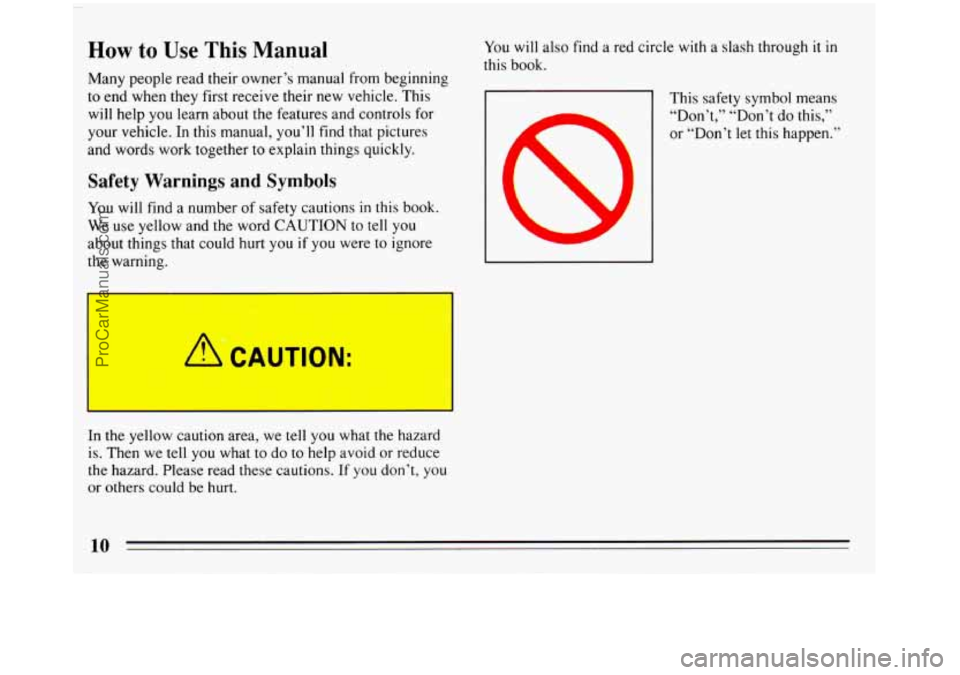
-
How to Use This Manual
Many people read their owner’s manual from beginning
to end when they first receive their new vehicle. This
will help
you learn about the features and controls for
your vehicle. In this manual,
you’ll find that pictures
and words
work together to explain things quickly.
Safety Warnings and Symbols
You will find a number of safety cautions in this book.
We use yellow and the word CAUTION to tell you
about things that could hurt
you if you were to ignore
the warning.
A CAUTION:
You will also find a red circle with a slash through it in
this book.
In
the yellow caution area, we tell you what the hazard
is. Then we tell you what to do to help avoid or reduce
the hazard. Please read these cautions. If you don’t, you
or others could be hurt.
1 This safetv symbol means
“Don’t,” “Don’t do this,”
or “Don’t let this happen.” <<
ProCarManuals.com
Page 13 of 308
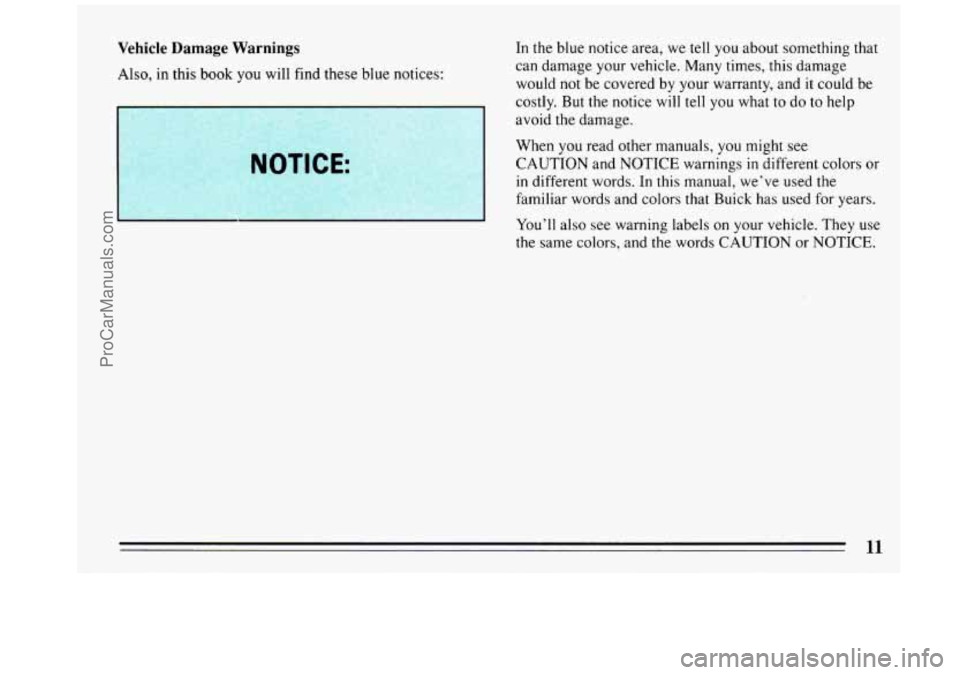
Vehicle Damage Warnings
Also, in this book you will find these blue notices:
NOTICE:
In the blue notice area, we tell you about something that
can damage your vehicle. Many times, this damage
would not be covered by your warranty, and
it could be
costly. But the notice will tell
you what to do to help
avoid the damage.
When you read other manuals, you might see
CAUTION and NOTICE warnings in different colors or
in different words.
In this manual, we’ve used the
familiar words and colors that Buick has used for years.
You’ll also see warning labels on your vehicle. They use
the same colors, and the words CAUTION or NOTICE.
11
ProCarManuals.com
Page 14 of 308

Vehicle Symbols
These are some of the symbols you will find on your vehicle.
For example,
these symbols
are used on an
original battery:
POSSIBLE A
CAUTION
INJURY
PROTECT EYES BY
SHIELDING
CAUSTIC
BURNS AVOID
SPARKS
OR
FLAMES
SPARK
OR ,\I/,
COULD FLAME
EXPLODE BATTERY
These symbols
are important
for you and
your passengers
whenever your
vehicle
is
driven:
DOOR LOCK
UNLOCK
e
e
BELTS 4
POWER
WINDOW
These symbols
have
to do with
your lights:
SIGNALS e @
TURN
HIGH BEAM
OR = =o
FOG LAMPS $0
These symbols
are on some
of
your controls:
WINDSHIELD ' ' ' 0- 0-
WASHER
WINDSHIELD WASHER
WINDOW
DEFOGGER
VENTILATING FAN
HEADLAMP
-
WIPER
WASHER
Q
These symbols
are
used on
warning and
indicator lights:
COOLANT F-
TEMP --
ENGINE
CHARGING
I-1
BATTERY SYSTEM
BRAKE
(0)
RADIATOR 0
COOLANT
FUEL
ENGINE OIL w,
PRESSURE
TEMP
OIL &b
ANTILOCK (a)
BRAKE
Here are some
other symbols
you may see:
FUSE
RADIO
VOLUME
CONDITIONING
AIR 43
HATCHBACK TRUNK
RELEASE
t LIGHTER
HORN
SPEAKER
12
ProCarManuals.com
Page 27 of 308
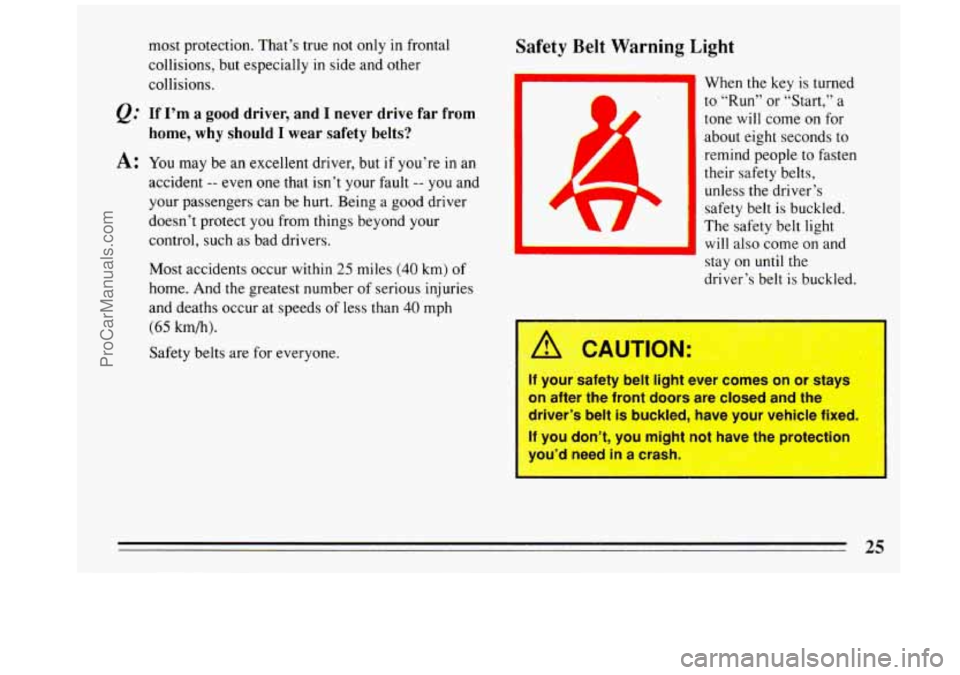
most protection. That’s true not only in frontal
collisions, but especially in side and other
collisions.
Q.’ If I’m a good driver, and I never drive far from
home, why should
I wear safety belts?
A: You may be an excellent driver, but if you’re in an
accident -- even one that isn’t your fault -- you and
your passengers can be hurt. Being a good driver
doesn’t protect you from things beyond your
control, such as bad drivers.
Most accidents occur within
25 miles (40 km) of
home. And the greatest number of serious injuries
and deaths occur at speeds of less than
40 mph
(65 km/h).
Safety belts are for everyone.
Safety Belt Warning Eight
L J When the key is turned
to “Run” or “Start,” a
tone will come
on for
about eight seconds to
remind people
to fasten
their safety belts, unless the driver’s
safety belt
is buckled.
The safety belt light
I I will also come on and
stay on
until the
driver’s belt is buckled.
I
A CAUTION:
If your safety belt light ever comes on or stays
on after the front doors are closed and the
driver’s belt
is buckled, have your vehicle fixed.
I If you don’t, you might not have the Drotection
you’d need in a crash.
I I
25
ProCarManuals.com
Page 59 of 308
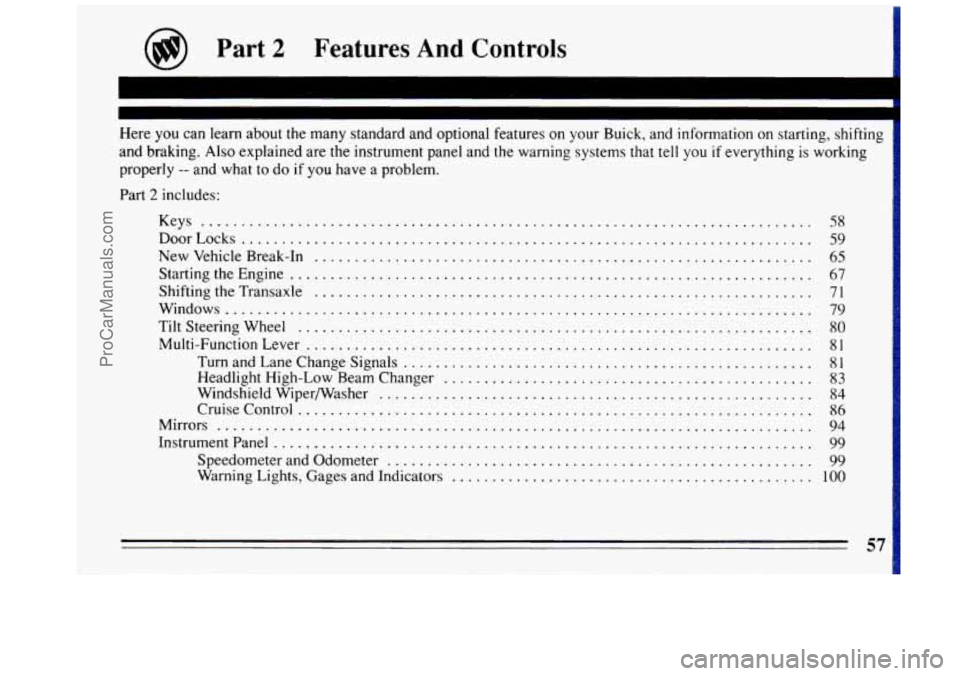
'art 2 Features And Controls
Here you can learn about the many standard and optional features on your Buick. and information on .. starting. shifting ..
and braking . Also explained are the instrument panel and
properly
.. and what to do if you have a problem .
Part 2 includes: the warning
systems that tell you
if every
Thing is working
Keys ........................................................................\
....
DoorLocks ....................................................................... \
NewVehicleBreak-In ..............................................................
StartingtheEngine .................................................................
ShiftingtheTransaxle ..............................................................
Windows ........................................................................\
.
TiltSteeringWheel ................................................................
Multi-FunctionLever ...............................................................
TurnandI, aneChangeSignals ...................................................
Headlight High-Low Beam Changer ..............................................
WindshieldWiper/Washer ......................................................
Cruisecontrol ................................................................
Mirrors ........................................................................\
..
Instrumentpanel ...................................................................
Speedometer and Odometer .....................................................
Warning Lights, Gages and Indicators .............................................
58
59
65
67
71
79
80
81
81
83
84
86
94
99
99
100
ProCarManuals.com
Page 76 of 308
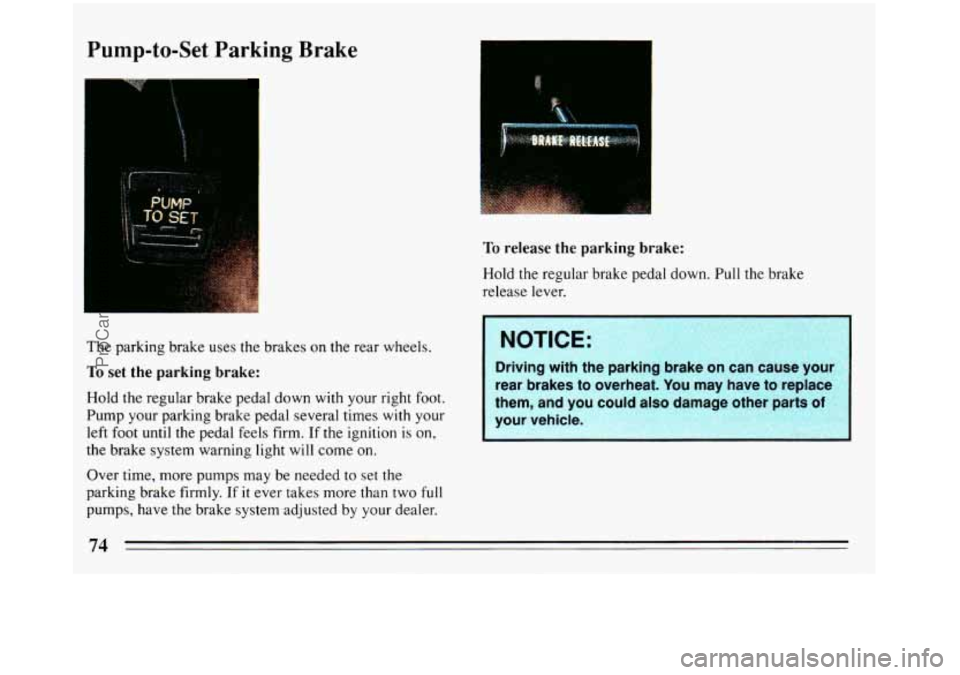
Pump-to-Set Parking Brake
The parking brake uses the brakes on the rear wheels.
To set the parking brake:
Hold the regular brake pedal down with your right foot.
Pump your parking brake pedal several times with your
left foot until the pedal feels firm. If the ignition is on,
the brake system warning light will come on.
Over time, more pumps may be needed to set the
parking brake firmly.
If it ever takes more than two full
pumps, have the brake system adjusted by your dealer.
To release the parking brake:
Hold the regular brake pedal down. Pull the brake
release lever.
.
NOTIC% I
Driving with the parking brake on can cause your
rear brakes to overheat. You may have to replace
your vehicle. them, and
you could also damage
74
ProCarManuals.com
Page 94 of 308

Headlight “On” Warning
If the light switch is left on you’ll hear a warning tone
when you turn the ignition
off and open the driver’s
door.
Fog Eights (GS Only Option)
If you have the fog light
feature, the control is on the
instrument. The parking
lights must be on, for the
fog lights to work. The fog
lights will turn off
when
you switch to high beam
headlights. When you
switch back to
low beam
headlights they
will turn
back on.
Daytime Running Lights (Canada Only)
The Canadian Federal Government has decided that
“Daytime Running Lights”
(DRL) are a useful feature,
in that DRL can make your vehicle more visible to
pedestrians and other drivers during daylight hours.
DRL are required on new vehicles sold
in Canada.
Your DRL work
with a light sensor on top of the
instrument panel. Don’t cover
it up.
The low beam headlights will come on at reduced
brightness
in daylight when:
0 The ignition is on
The headlight switch is off, and
The parking brake is released.
At dusk, the exterior lights will come on automatically
and the low beams will change to.full brightness.
At
dawn, the exterior lights will go out and the low beams
will change to the reduced brightness of DRL (if the
headlight switch
is off>. Of course, you may still turn on
the headlights any time you need to. To idle your vehicle
with the DRL off. set the parking brake while the
ignition
is in the “Off“ or “l,ock” position. Then start
the vehicle. The DRL
will stay off until you release the
parking brake.
92
ProCarManuals.com